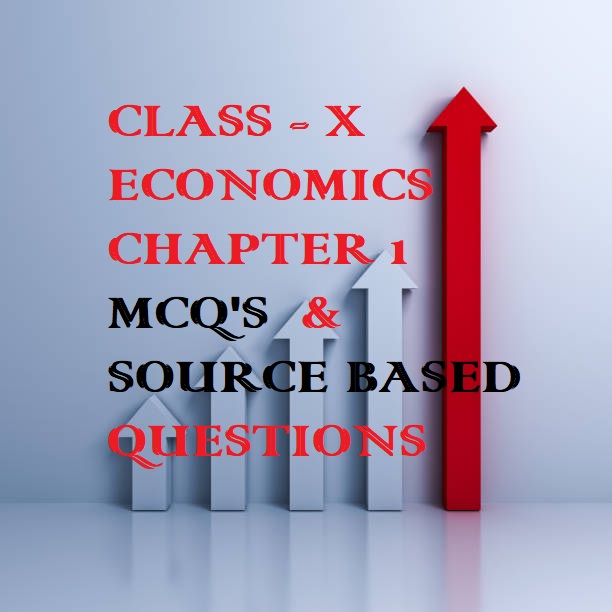Social Science Class 10 Economics Chapter 1 Development : MCQ’s & Source Based Questions
Welcome to the intriguing world of Social Science Class 10 Economics, where we embark on a journey through Chapter 1: “Development.” This chapter delves into the multifaceted concept of development, exploring its dimensions, indicators, and various approaches to measuring progress. Through a blend of Multiple Choice Questions (MCQs) and Source Based Questions, students will unravel the complexities of economic development, understanding its impact on societies and nations. Engaging with these questions will not only enhance comprehension but also encourage critical thinking about the global challenges and opportunities associated with development. Let’s delve into the realm of economics and development with a curious and analytical mindset.
Social Science Class 10 Economics Chapter 1 Development : MCQ’s & Source Based Questions
Multiple Choice Questions With Answers:
Q1. What is the most common method for measuring countries development?
a) Quality of Life
b) Income of the country.
C) Environmental sustainability
d) Life expectancy
Q2. “When students engage in open discussions about development indicators, they will engage in arguments and present their individual perspectives. This will achieve a couple of objectives:
a) They will recapitulate the concepts that were discussed.
b) This process will connect learners more closely to real-life scenarios.
c) Both option a and option b.
d) Only option b.
Q3. What will be the developmental goal of a landless laborer?
a) a good college for higher studies
b) Modern banking system
c) more days of work and better wages
d) higher support prices for their crops.
Q4. Identify the incorrect statement
a) different persons can have different developmental goals.
b) what may be development for one will also be development for the other.
c) different developmental goals may even be destructive for others.
d) two persons or groups of persons may seek things which are conflicting
Q5. Besides seeking more income, one way or the other, people do not seek things like
a) equal treatment,
b) freedom & security,
c) respect of others
d) discrimination in society.
Answers
- b) Income of the country. 2. c) Both option a and option 3. c) more days of work and better wages 4. b) what may be development for one will also be development for the other. 5. d) discrimination in society.
Social Science Class 10 Economics Chapter 1 Development : MCQ’s & Source Based Questions
Multiple Choice Questions With Answers:
Q6. The quality of our life also depends on non-material things. Identify the non-material things from the list given below.
a) house, car, & mobile phones.
b) Equality, neat and clean environment, respect for others.
c) a good school, railway station nearby and well equipped hospital.
d) All of the above.
Q7. Why do industrialists want more dams?
a) for more electricity
b) for submergence of land.
c) for displacement of people
d) to take revenge from tribal people.
Q8. World Development Reports are brought out by the
a) World bank
b) United Nations
c) International Monetary Fund (IMF)
d) Reserve Bank of India.
Q9. Which of the following countries are excluded from the list of developed countries in the modern world?
a) American countries like USA & Canada.
b) European countries like France and Germany
c) Middle East Countries like Saudi Arabia and Iran
d) None of the above.
Q10. According to the World Development Reports, brought out by the_________, per capita income criterion is used in classifying countries.
a) UNICEF
b) World Bank
c) World Economic Forum
d) United Nations
Answers
6. b) Equality, neat and clean environment, respect for others. 7. a) for more electricity 8. a) World bank 9. c) Middle East Countries like Saudi Arabia and Iran 10. b) World Bank
Social Science Class 10 Economics Chapter 1 Development : MCQ’s & Source Based Questions
Multiple Choice Questions With Answers:
Q11. What term is used to describe countries that had a per capita income of US$ 12,616 or higher in 2012?
a) Underdeveloped countries
b) Developing countries
c) Poor countries
d) Rich countries
Q12. India is classified as a __________ income country due to its per capita income in 2012 being only US$ 1530 per annum.
a) Low middle income
b) Middle income
c) High middle income
d) None of the above
Q13. According to Infant Mortality Rate (IMR), it signifies the number of children who perish before the age of __________, expressed as a percentage of 100 live children born in that specific year.
a) Four years
b) One year
c) Two years
d) Three years
Q14. The literacy rate gauges the proportion of the literate population in the _________ age bracket.
a) 10 and above
b) 21 and above
c) 7 and above
d) 18 and above
Q15. The Net Attendance Ratio calculates the total number of children belonging to the age group ________ who attend school as a percentage of the total number of children in the same age group.
a) 17 and 18 years
b) 9 and 10 years
c) 12 and 13 years
d) 14 and 15 years
Answers:
11. b) Developing countries 12. b) Middle income 13. b) One year 14. c) 7 and above 15. d) 14 and 15 years
Social Science Class 10 Economics Chapter 1 Development : MCQ’s & Source Based Questions
Multiple Choice Questions With Answers:
Q16. According to the 2011 census, which state among the following boasts the highest literacy rate?
a) Kerala
b) Maharashtra
c) Bihar
d) Odisha
Q17. HDI stands for Human Development Index that focused on ________________
a) National Income
b) Life expectancy
c) Net attendance ratio
d) All of the above.
Q18. Which of the following countries has higher HDI than India?
a) Bhutan
b) Bangladesh
c) Sri Lanka
d) Pakistan
Q19. Pick out the correct meaning listed below to define the term Average Income.
a) total income of the country
b) income of only employed people
c) includes the total property held.
d) it is the same as the per capita income.
20. ______________ proportion of the country is overusing the groundwater resource.
a) One-Third
b) One-Fourth
c) One-Tenth
d) Half
Answers:
16. a) Kerala 17. d) All of the above. 18. c) Sri Lanka 19. d) it is the same as the per capita income. 20. a) One-Third
Social Science Class 10 Economics Chapter 1 Development : MCQ’s & Source Based Questions
Source Based Questions With Answers:
Do all of these persons have the same notion of development or progress? Most likely not. Each one of them seeks different things. They seek things that are most important for them, i.e., that which can fulfil their aspirations or desires. In fact, at times, two persons or groups of persons may seek things which are conflicting. A girl expects as much freedom and opportunity as her brother, and that he also shares in the household work. Her brother may not like this. Similarly, to get more electricity, industrialists may want more dams. But this may submerge the land and disrupt the lives of people who are displaced – such as tribals. They might resent this and may prefer small check dams or tanks to irrigate their land.
So, two things are quite clear: one, different persons can have different developmental goals and two, what may be development for one may not be development for the other. It may even be destructive for the other.
you will notice one common thing: what people desire are regular work, better wages, and decent price for their crops or other products that they produce. In other words, they want more income. Besides seeking more income, one way or the other, people also seek things like equal treatment, freedom, security, and respect of others. They resent discrimination. All these are important goals. (courtesy NCERT)
Read the above paragraph and answer the questions given below:
Q1. Why do persons of the same notion differ in the process of development? 1.
Ans. Persons of the same notion differ in the process of development because
i) each one of them seek different things
ii) they seek things which can fulfill their desires and aspirations.
Q2. Explain with an example how can two persons seek things which are conflicting? 1.
Ans. Two persons may seek things which are conflicting because:
example: An industrialist may want more dams to get more electricity for his industries but construction of dams also leads to the submergence of land and displacement of people which may disrupt the lives of local people. Therefore, construction of dams may be advantageous for some and disasterous for others.
Q3. Mention any four things which people seek beside more income. 2.
Ans: Four things which people seek beside more income are:
i) equal treatment,
ii) freedom,
iii) security, and
iv) respect of others
Social Science Class 10 Economics Chapter 1 Development : MCQ’s & Source Based Questions
Source Based Questions With Answers:
Money, or material things that one can buy with it, is one factor on which our life depends. But the quality of our life also depends on non-material things mentioned above. If it is not obvious to you, then just think of the role of your friends in your life. You may desire their friendship. Similarly, there are many things that are not easily measured but they mean a lot to our lives. These are often ignored.
However, it will be wrong to conclude that what cannot be measured is not important. A job may give you less pay but may offer regular employment that enhances your sense of security. Another job, however, may offer high pay but no job security. This will reduce your sense of security and freedom.
Similarly, for development, people look at a mix of goals. It is true that if women are engaged in paid work, their dignity in the household and society increases. However, it is also the case that if there is respect for women there would be more sharing of housework and a greater acceptance of women working outside. (Courtesy: NCERT)
Read the above paragraph and answer the questions given below:
Q1. What are non-material things? 1.
Ans. The necessity of non-material aspects in our daily lives can vary, primarily centering on social dimensions such as security and respect. These intangible elements hold significant value for us and greatly influence our existence. Non-material assets encompass unique offerings that lack physical presence and are challenging to quantify.
Q2. Why it is wrong to conclude “what cannot be measured is not important”? 1.
Ans) It is wrong to conclude “what cannot be measured is not important” because
i) If you get a job in a far off place, before accepting it you would try to consider many factors, apart from income, such as facilities for your family, working atmosphere, or opportunity to learn.
ii) In another case, a job may give you less pay but may offer regular employment that enhances your sense of security. Another job, however, may offer high pay but no job security and also leave no time for your family. This will reduce your sense of security and freedom.
Q3. Do you agree that women engaged in paid work, their dignity and respect in the household and society increases. 2.
Ans) The statement suggests that when women are actively involved in paid employment, their dignity and respect within both the household and society tend to increase. This viewpoint is often grounded in the idea that economic independence and contributing to the workforce can empower women in several ways.
However, it’s important to note that the impact of women’s paid work on their dignity and respect can vary widely depending on cultural, societal, and individual factors. In some cases, women may still face challenges, such as gender discrimination or the burden of balancing work and family responsibilities, which can impact their overall well-being and the respect they receive.
Project On Women’s Empowerment: Analyzing Women’s Participation and Representation in Politics
Social Science Class 10 Economics Chapter 1 Development : MCQ’s & Source Based Questions
Source Based Questions With Answers:
for comparison between countries, total income is not such an useful measure. Since, countries have different populations, comparing total income will not tell us what an average person is likely to earn. Are people in one country better off than others in a different country? Hence, we compare the average income which is the total income of the country divided by its total population. The average income is also called per capita income. In World Development Reports, brought out by the World Bank, this criterion is used in classifying countries.
Countries with per capita income of US$ 49,300 per annum and above in 2019, are called high income or rich countries and those with per capita income of US$ 2500 or less are called low-income countries. India’s per capita income in 2019 was just US$6700 per annum.
Economics Project On Income Inequality: A Comprehensive Analysis For Class X
Read the above paragraph and answer the questions given below:
Q1. Why is total income not such an useful measure in comparing countries? 1.
Ans) Total income is not such an useful measure in comparing countries because countries have different populations, comparing total income will not tell us what an average person is likely to earn.
Q2. How will you calculate the average income of a country? 1.
Ans) Average income of a country can be calculated as the total income of the country divided by its total population.
Q3. Which criterion is used by the world bank in classifying countries? In which category India can be placed according to it’s per capita income? 2.
Ans) The Per Capita Income or the average income of the country is the criterion used by the world bank in classifying countries. India can be placed under middle income countries as it’s income is lower than US$ 49,300 and higher than US$6700 per annum.
Social Science Class 10 Economics Chapter 1 Development : MCQ’s & Source Based Questions
Source Based Questions With Answers:
let us consider two countries, A and B. For the sake of simplicity, we have assumed that they have only five citizens each.
| COUNTRY | COMPARISION OF TWO COUNTRIES (Table 1.2) | |||||
| MONTHLY INCOME OF CITIZENS (IN RUPEES) | ||||||
| I | II | III | IV | V | Average | |
| Country A | 9500 | 10,500 | 9800 | 10,000 | 10,200 | |
| Country B | 500 | 500 | 500 | 500 | 48,000 | |
Will you be equally happy to live in both these countries? Are both equally developed? Perhaps some of us may like to live in country B if we are assured of being its fifth citizen but if it is a lottery that decides our citizenship number then perhaps most of us will prefer to live in country A. Even though both the countries have identical average income, country A is preferred because it has more equitable distribution. In this country people are neither very rich nor extremely poor. On the other hand most citizens in country B are poor and one person is extremely rich. Hence, while average income is useful for comparison it does not tell us how this income is distributed among people. (Courtesy NCERT)
11 Point Project On Consumer Awareness
Read the above paragraph and answer the questions given below:
Q1. Calculate the average income of both the countries. 1.
Ans) Average income of country A is
Total income of the country divided by it’s total population
Country A = 9500+10,500+9800+10,000+10,200 = 50000 / 5 = Rupees10,000
Average income of country B is
Total income of the country divided by it’s total population
Country B = 500+5000+500+500+48000 = 50,000 / 5 = Rupees 10,000
Therefore, the average income of both the countries are same as Rupees 10,000
Q2. Are both the countries equally developed? Give reasons. 1.
Ans) No, Even though both the countries have identical average income, country A is preferred because it has more equitable distribution of income.
Q3. Which country has more number of poor people? Why is average income not a better criteria to compare countries? 2.
Ans) Country B has more number of poor people. Average income is not a better criteria to compare countries because it does not tell us how this income is distributed among people. Average income hide disparities.
Social Science Class 10 Economics Chapter 1 Development: MCQ’s & Source Based Questions
Conclusion:
Chapter 1 of Class 10 Economics, titled “Development,” offers a comprehensive foundation for understanding the complex concept of development. The incorporation of MCQs (Multiple Choice Questions) and source-based questions into the curriculum is a valuable pedagogical tool. These questions not only test students’ knowledge but also encourage critical thinking and analytical skills. By engaging with different sources and perspectives, students can develop a deeper understanding of economic development and its multifaceted nature. Furthermore, MCQs provide an effective means of self-assessment and exam preparation, helping students gauge their comprehension and identify areas for improvement. Overall, this chapter equips students with the essential knowledge and skills needed to grasp the intricate dynamics of development in the modern world, empowering them to be informed global citizens.
Class X Resources & Development – How To Write Perfect Answers In Points
60 Most Expected Geography Questions In Term I From Class X





0 Comments